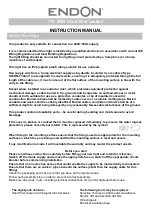
Step 4. Connecting and tightening the line
•
Make sure both ends of the line are secured at the same height.
•
With the ratchet handle facing down, feed the end of the main line through the ratchet axle slot.
Make sure line is not twisted or folded as this could damage or break the line or ratchet.
•
Pull the line tight through the ratchet axle slot so there is no slack in the webbing. The ratchet spool
can only hold about 2 feet of line,
so it’s necessary to pull the line as tight as possible before using
the ratchet. Do not overfill the ratchet spool or it can become jammed and unable to unwind.
•
Pull on ratchet release lever to unlock ratchet handle. Use ratchet handle to tighten further by
cranking the handle back and forth.
•
Keep ratcheting the line tighter until the line is as tight as you can make it (but do not exceed 100
pounds of force on the handle). When fully tightened, pull release lever to close and lock handle in
place. If ratchet handle is not locked closed, the line could unwind suddenly and cause injury.
Step 3. Attaching obstacles
•
Select desired positions for obstacles. Shorter distances apart are recommended for smaller users
(approximately 14 inches apart is a good place to start). First obstacle, typically the climbing ladder,
should be placed 6-10 feet from tree on the main line. Do not attach obstacles to the anchor line.
•
With webbing hook on underside of line and hook flanges on top, pull line through webbing hook to
make a loop. See Images 1 and 2.
•
Thread triangle carabiner through the line loop. Do not attach triangle carabiners to webbing hooks.
See Images 3 and 4.
•
Attach obstacles to triangle carabiners in desired order. Lock carabiner by twisting the nut closed.
1. Clip Hook
on Underside
of Slackline
2. Pull Slackline
through Hook
into a Loop
3. Attach Triangle
Carabiner to
Slackline Loop
4. Pull Slackline
Snug, Slide Hook
into Position
Pull Line Tight
Before Ratcheting
Ratchet Handle in
Locked Position
Line Threads Through
Ratchet Axle Slot


























